Power electronic handbook
Подождите немного. Документ загружается.


1018 B. Karanayil and M. F. Rahman
v
s
ds
(k)
w
r
est
ANN Based
Speed
Estimator
Speed
v
s
ds
(k−1)
v
s
qs
(k)
v
s
qs
(k−1)
i
s
ds
(k)
i
s
ds
(k−1)
i
s
qs
(k)
i
s
qs
(k−1)
FIGURE 36.6 ANN-based speed estimator for induction motor.
Performance is 0.000499018, Goal is 0.0005
Training for three samples of voltages and
four samples of currents
10
1
10
0
10
−1
10
−2
10
−3
10
−4
0 5 10 15 20 25
48 Epochs
30 35 40 45
FIGURE 36.7 The error plot of 8 × 7 × 1 network training for speed
estimation.
nodes. In this speed estimator ANN, 7 hidden neurons were
selected.
The results of an experiment conducted on a 1.1 kW, 415 V,
3 phase, 4 pole, 50 Hz induction motor is explained in this
section. In order to investigate the case of speed estimation
using ANN, a rotor flux oriented induction motor drive was
set up in the laboratory, where the speed reference was changed
in steps of 100 rpm and reversed every time the speed reached
1000 rpm. The load torque on the motor was kept constant at
its full load rating. The stator voltages, stator currents, and the
rotor speed were measured for 5 s and a data file was generated.
The neural network was then trained using the trainlm algo-
rithm with this data file. The training of the neural network
converged after 48 epochs and the error plot for this network
training is shown in Fig. 36.7. The estimated speed was pre-
dicted with the trained neural network, and the result is shown
in Fig. 36.8.
The noisy data in the plot is the estimated speed and the
continuous line is the speed measured with the encoder. The
speed estimation was found to fail for speeds less than 100 rpm.
If the trained neural network has to predict the speed under the
complete range of operation of the drive, the data for training
the neural network also has to be taken for the whole range.
From this example investigated, it was found that the off-line
training of the neural network could not produce satisfactory
results, and it can be concluded that these off-line methods are
not most suitable for these applications.
Artificial neural networks was also used for the estimation of
the rotor speed of an induction motor together with the help
of induction motor dynamic model. Though the technique
gives a fairly good estimate of the speed, this technique lies
more in the adaptive control area than in neural networks.
The speed is not obtained at the output of a neural network;
instead, the magnitude of one of the weights corresponds to
the speed. The four quadrant operation of the drive was not
possible for speeds less than 500 rpm. The motor was not able
to follow the speed reference during the reversal for speeds less
than 500 rpm. The drive worked satisfactorily for speeds above
500 rpm. Even though this method does not fall into a true
neural network estimator, the results achieved with this type
of implementation were very good except for lower speeds.
Alternately, the estimated speed can be made available at
the output of a neural network as shown in Fig. 36.9. This
speed estimator used a three layer neural network with five
input nodes, one hidden layer, and one output layer to give
the estimated speed ˆω
r
(k) as shown in Fig. 36.9. The three
inputs to the ANN are a reference model flux λ
∗
r
, an adjustable
model flux
ˆ
λ
r
, and ˆω
r
(k−1), the time delayed estimated speed.
The multilayer and recurrent structure of the network makes
it robust to parameter variations and system noise. The main
advantage of their ANN structure lies in the fact that they
have used a recurrent structure which is robust to parameter
variations and system noise. These authors were able to achieve
a speed control error of 0.6% for a reference speed of 10 rpm.
The speed control error dropped to 0.584% for a reference
speed of 1000 rpm.
36.3.2 Flux and Torque Estimation
The same principle as described in Section 36.3.1 can also be
extended for simultaneous estimation of more quantities such
as torque and stator flux. When more quantities or variables
have to be estimated, the complex ANN has to implement a
complex non-linear mapping.
The four feedback signals required for a direct field
oriented induction motor drive can be estimated using ANNs.
A4×20 ×4 multilayer network has been used for the estima-
tion of the rotor flux magnitude, the electromagnetic torque,
and the sine/cosine of the rotor flux angle. It has been demon-
strated both by modeling and experimental results that the
above estimated quantities were almost equal to the same
quantities computed by a DSP-based estimator. Both the esti-
mated torque and rotor flux signals using neural network
was found to have higher ripple content compared to the
DSP-based estimated quantities. It could be concluded that
a properly trained ANN could totally eliminate the machine
model equations as is evident from the results reported.
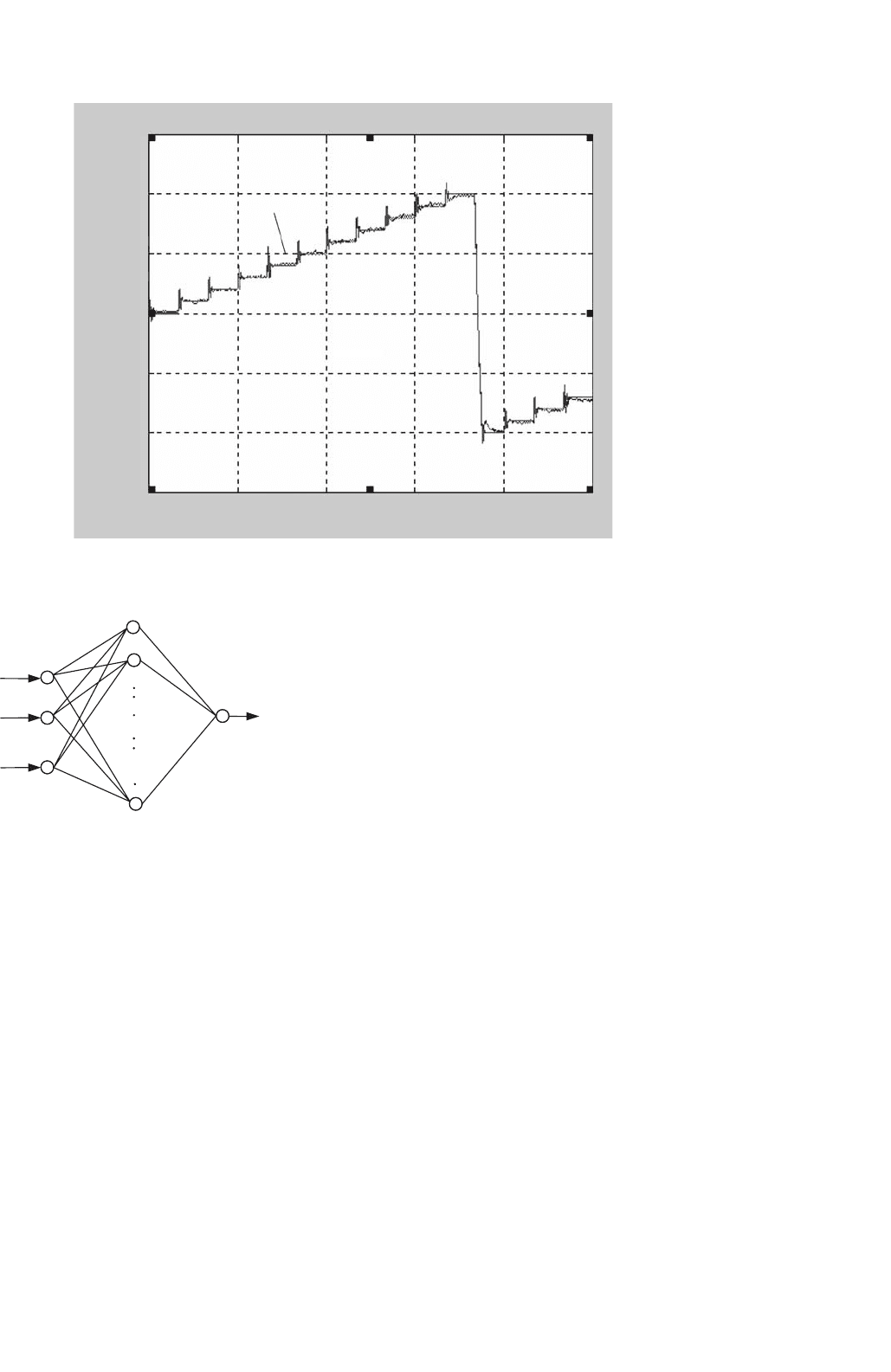
36 ANN Applications in Power Electronics and Electrical Drives 1019
Time (second)
0
−1500
−1000
−500
0
500
1000
1500
12345
Measured speed
Speed (rev/min)
Estimated speed
FIGURE 36.8 Measured speed vs estimated speed with ANN for induction motor.
w
r
(k − 1)
w
r
(k)
l
r
*
(k)
l
r
(k)
ˆ
ˆ
FIGURE 36.9 Structure of the neural network for the induction motor
speed estimation.
In another application, an ANN with 5×8 ×8 ×2 structure
has been used to estimate the stator flux using the measured
induction motor stator variables quantities. After successful
training, the ANN was used in a direct field oriented controlled
drive. The rotor flux is computed from the stator flux estimate
provided by the ANN and the stator current. This particular
implementation also included an ANN-based decoupler which
was used for the indirect field oriented (IFO) drive. An ANN
with a structure of 2×8×8×1 was used for implementing the
mapping between the flux and torque references and the stator
current references. The estimated rotor flux using an ANN and
a conventional FOC controller was shown to be equal. These
authors have used experimental data for the ANN training and
thus the effect of motor parameters was reduced. The authors
were unable to use these estimated fluxes for controlling the
induction motor in the experiment. The structure of the ANN
used for this estimation is only that of a static ANN. It is
preferable to have a dynamic neural network for this purpose.
36.3.3 Rotor Resistance Identification
Using ANN
36.3.3.1 Off-line Trained ANN
The artificial neural network can also be used for the rotor
time constant adaptation in indirect field oriented controlled
drives. One of the implementation reported in the literature is
shown in Fig. 36.10. There are five inputs to the T
r
estimator,
namely v
s
ds
, v
s
qs
, i
s
ds
, i
s
qs
, ω
r
. The training signals are generated
with step variations in rotor resistance for different torque
reference T
∗
e
and flux command λ
∗
r
and the final network is
connected in the IFO controller as shown in Fig. 36.10. The
rotor time constant was tracked by a proportional integral (PI)
regulator that corrects any errors in the slip calculator. The
output of this regulator is summed with that of the slip calcu-
lator and the result constitutes the new slip command that is
required to compensate for the rotor time constant variation.
The major drawback of this scheme is that the final neural net-
work is only an off-line trained neural network with a limited
data file obtained from the modeling.
36.3.3.2 On-line Trained ANN
The limitations of off-line trained ANN are overcome by using
an on-line trained ANN configuration. The method discussed
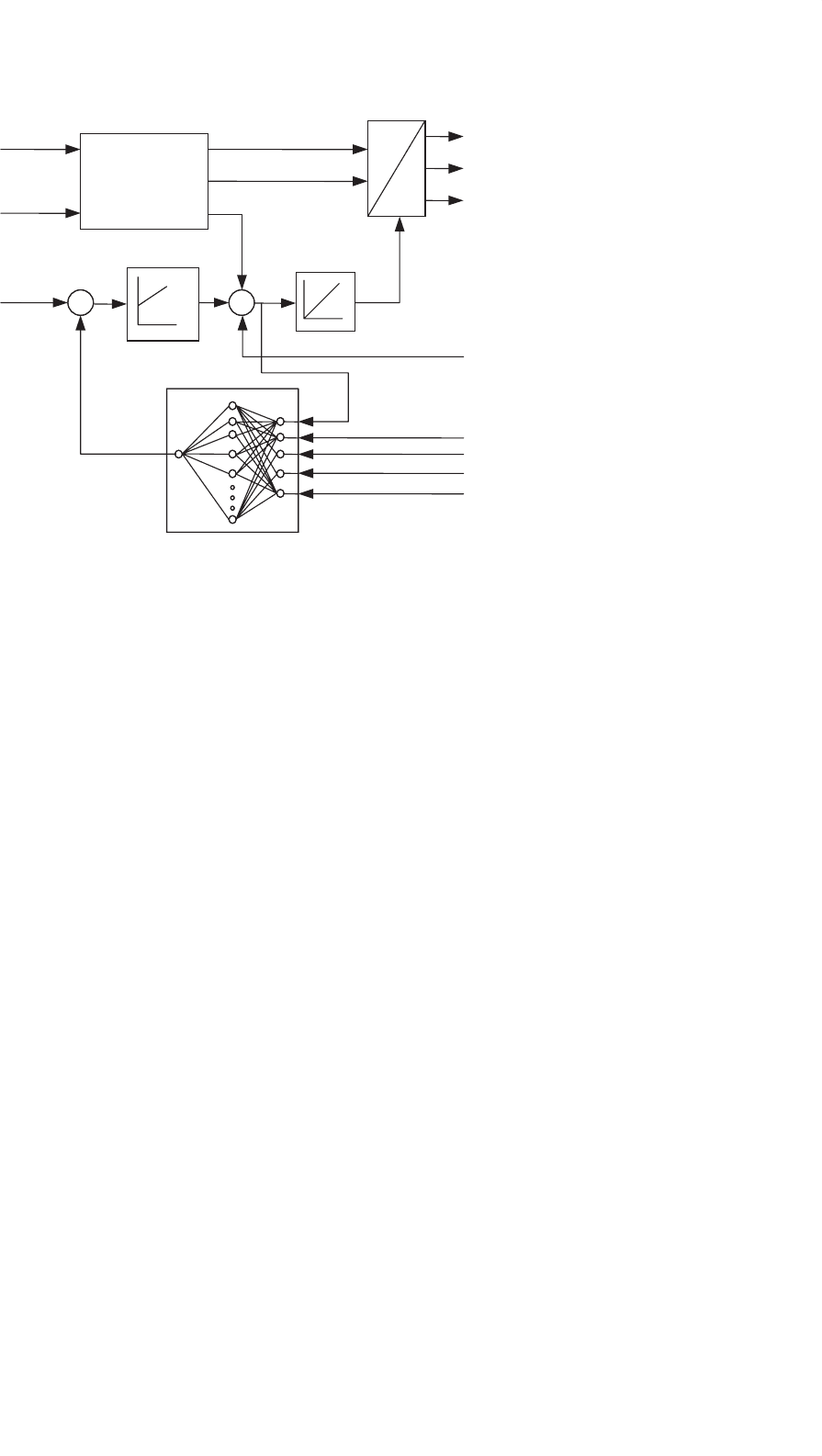
1020 B. Karanayil and M. F. Rahman
d −q
q
T
e
*
l
r
*
+
+
+
+
_
w
Calculation
of
w
sl0
, i
*
ds
, i
*
qs
T
r 0
ˆ
T
r
ˆ
i
*
ds
i
*
qs
w
sl0
a, b, c
i *
a
i *
b
i *
c
w
r
v
s
ds
v
s
qs
i
s
qs
i
s
ds
FIGURE 36.10 Principle of rotor time constant adaptation.
in this section has used an on-line trained ANN for adap-
tation of R
r
of an induction motor in the RFOC induction
motor drive. The error between the desired state variable of
an induction motor and the actual state variable of a neural
model is back propagated to adjust the weights of the neural
model, so that the actual state variable tracks the desired value.
The principle of on-line estimation of rotor resistance (R
r
)
with multilayer feedforward artificial neural networks using
on-line training has been described in Section 36.3.3.2.1. This
technique was then investigated with the help of modeling
studies with a 1.1 kW squirrel-cage induction motor (SCIM),
described in Section 36.3.3.2.2. The modeling results are pre-
sented in Section 36.3.3.2.3. In order to validate the modeling
studies, modeling results were compared with those from
an experimental set-up with a SCIM under RFOC. These
experimental results are presented in Section 36.3.3.2.4.
36.3.3.2.1 Multilayer Feedforward ANN Multilayer feed-
forward neural networks are regarded as universal approx-
imations and have the capability to acquire non-linear
input–output relationships of a system by learning via the
back-propagation algorithm. It should be possible that a
simple two-layer feedforward neural network trained by the
back-propagation technique can be employed in the rotor
resistance identification. The modified technique using ANN
proposed in this section can be implemented in real time
so that the resistance updates are available instantaneously
and there is no convergence issues related to the learning
algorithm. The two-layered neural network based on a back-
propagation technique is used to estimate the rotor resistance.
Two models of the state variable estimation are used, one pro-
vides the actual induction motor output and the other one
gives the neural model output. The total error between the
desired and actual state variables is then back propagated as
shown in Fig. 36.11, to adjust the weights of the neural model,
so that the output of this model coincides with the actual
output. When the training is completed, the weights of the
neural network should correspond to the parameters in the
actual motor.
36.3.3.2.2 Rotor Resistance Estimation for RFOC Using ANN
The basic structure of an adaptive scheme described by
Fig. 36.11 is extended for rotor resistance estimation of an
induction motor as illustrated in Fig. 36.12. Two independent
observers are used to estimate the rotor flux vectors of the
induction motor. If the rotor flux linkages are estimated using
the stator voltages and stator currents, they are referred to
as voltage model and if the rotor flux linkages are estimated
using the stator currents and rotor speed they are referred to
as current model.
The stator flux linkages based on the neural network model
in Fig. 36.12 can be represented using Eq. (36.5), which is
derived from the sample data models of the combined voltage
and current model equations of the induction motor.
−−→
λ
s
nm
r
k
= W
1
X
1
+W
2
X
2
+W
3
X
3
(36.5)
The neural network model represented by Eq. (36.5) is
shown in Fig. 36.13, where W
1
, W
2
, and W
3
represent the
weights of the networks and X
1
, X
2
, X
3
are the three inputs to
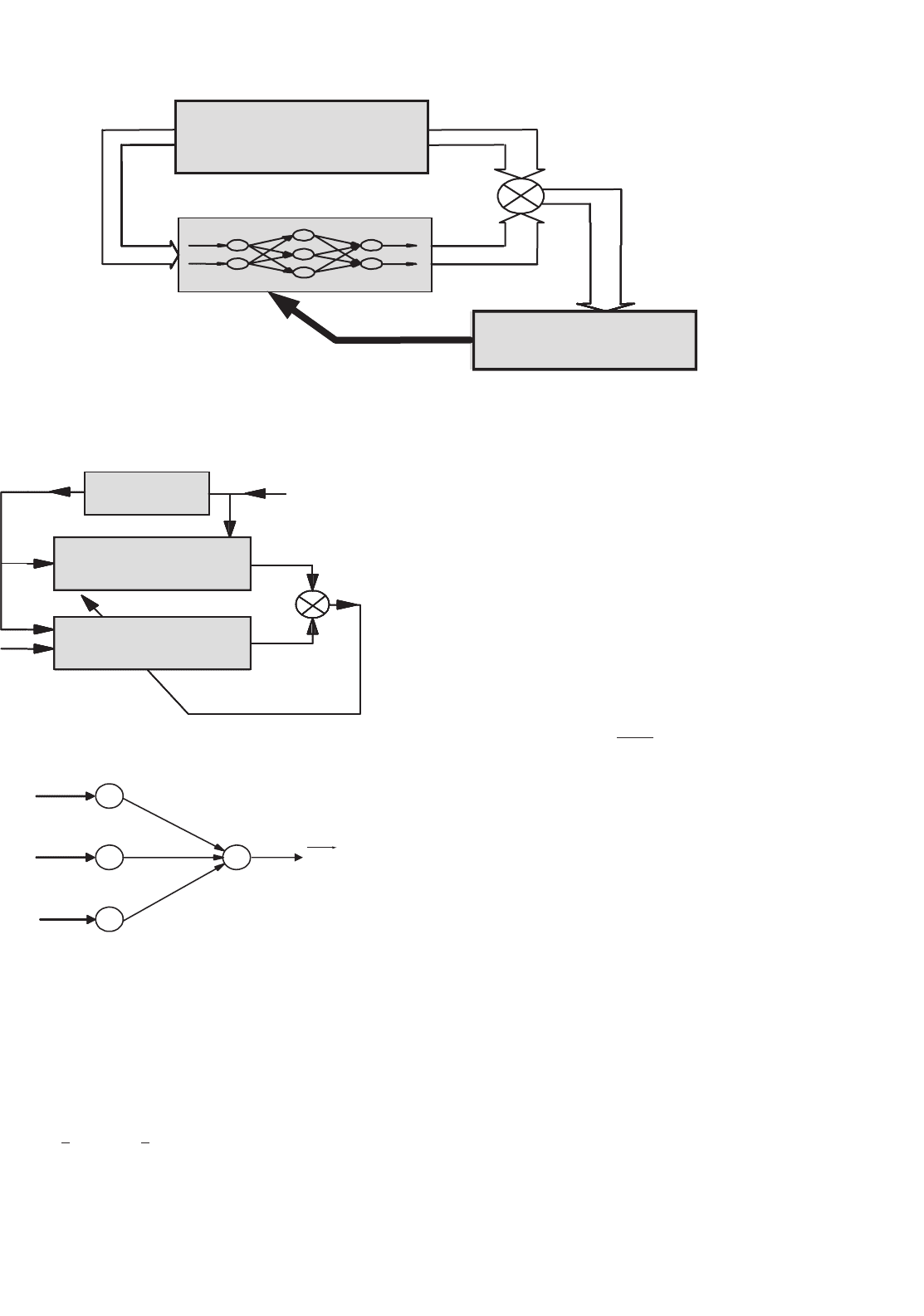
36 ANN Applications in Power Electronics and Electrical Drives 1021
Desired state
variable
Back Propagation
State
variable
Weights
Actual induction Motor
+
−
Neural Network Model of Induction Motor
FIGURE 36.11 Block diagram of rotor resistance identification using neural networks.
+
−
i
s
s
→
v
s
s
→
l
s
r
l
r
nm
→
→
i
s
s
→
i
s
s
→
w
r
Induction Motor
Induction Motor
Voltage Model
Induction Motor
Current Model
(Neural Network Model)
Weight = R
r
ˆ
vm
e
1
→
FIGURE 36.12 Structure of the neural network system for R
r
estimation.
X
1
W
1
W
2
W
3
X
2
X
3
+
nm
l
r
s
(k)
FIGURE 36.13 Two-layered neural network model for rotor flux link-
age estimation.
the network. If the network shown in Fig. 36.13 has to be used
to estimate R
r
, where W
2
is already known, then W
1
and W
3
need to be updated.
The weights of the network, W
1
and W
3
are found from
training, so as to minimize the cumulative error function E
1
,
E
1
=
1
2
ε
1
2
k
=
1
2
−−→
λ
s
vm
r
k
−
−→
λ
s
im
r
k
2
(36.6)
The weight of the neural network W
1
has to be adjusted
using generalized delta rule.
To accelerate the convergence of the error back-propagation
learning algorithm, the current weight adjustment has to be
supplemented with a fraction of the most recent weight
adjustment, as indicated in Eq. (36.7).
W
1
k
= W
1
k − 1
−η
1
δX
2
+α
1
W
1
k − 1
(36.7)
where α
1
is a user-selected positive momentum constant and
η
1
is the training coefficient.
The rotor resistance R
r
can now be calculated from W
3
from
Eq. (36.8) as follows:
ˆ
R
r
=
L
r
W
3
L
m
T
s
(36.8)
36.3.3.2.3 Modeling Results A schematic diagram showing
the implementation of a rotor resistance estimator in RFOC
controller for induction motor is shown in Fig. 36.14. The
stator voltages and currents are measured to estimate the rotor
flux linkages using the voltage model as shown in this figure.
The inputs to the rotor resistance estimator (RRE) are the
stator currents, rotor flux linkages λ
s
vm
dr
, λ
s
vm
qr
, and the rotor
speed ω
r
. The estimated rotor resistance
ˆ
R
r
will then be used
in the RFOC controllers for the flux model. The response of
the drive together with the rotor resistance estimator OFF is
shown in Fig. 36.15 for an abrupt change in R
r
of motor, from
6.03 to 8.5 at 0.8 s. The possible changes in the estimated
motor torque T
e
, the rotor flux linkage λ
rd
with this estimator
were noted.
Subsequently the results of the drive were looked at with
RRE ON, so that the rotor resistance in the controller R
r
was
updated with the estimated rotor resistance
ˆ
R
r
as shown in
Fig. 36.16. The estimated rotor resistance
ˆ
R
r
has converged to
the rotor resistance of the motor R
r
within 50 ms.
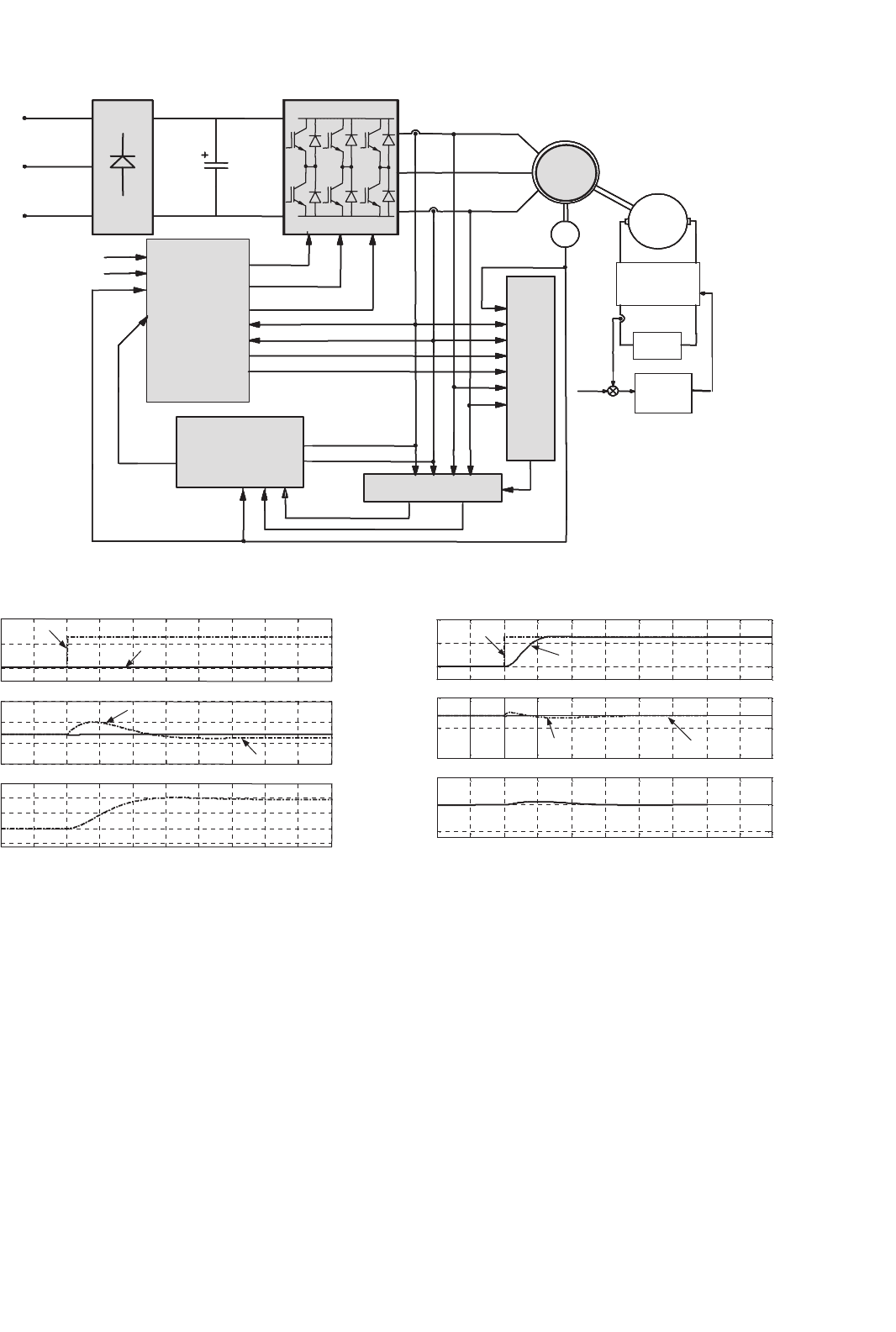
1022 B. Karanayil and M. F. Rahman
w
r
pwm_a
pwm_b
pwm_c
Rotor Resistance
Estimator [RRE]
Using
Neural Networks
C
Controller
Voltage Model of IM
IM
E
Rotor Flux
Oriented
Vector
3 Phase AC Supply
w
mref
l
rdref
R
r
ˆ
l
s
dr
R
s
ˆ
vm
l
s
dr
im
l
s
qr
vm
l
s
qr
im
i
a
v
a
i
c
v
c
DCG
DC/DC
Converter
LOAD
Current
Controller
i
L ref
i
L
Stator Resistance Estimator
[SRE]
Using Neural Network
FIGURE 36.14 Block diagram of the RFOC induction motor drive with on-line rotor and stator resistance tracking using ANN.
6
8
10
6
7
8
9
0.7 0.75 0.8 0.85 0.9 0.95 1 1.05 1.1 1.15 1.2
0.9
1
1.1
1.2
Time (second)
Estimated
Motor
R
r
(Ω)
R
r
R ′
r
T
e
(Nm)
l
r
(Wb)
FIGURE 36.15 Effect of rotor resistance variation without rotor resis-
tance estimator for 40% step change in R
r
– modeling results.
The response of the drive system with the RRE using ANN
are also shown for a practical profile in load torque, speed, and
change in R
r
. The R
r
was increased from 6.03 to 8.5 over a
period of 8 s and the torque and rotor flux linkage are shown
in Fig. 36.17 when the RRE is OFF. For rapid reversals of the
drive and variations in load torque, there are significant errors
in rotor flux linkages and thus errors in estimated torques.
Subsequently, the RRE block was switched ON and it can
be observed that the rotor resistance estimator was tracking
very well even during the worst dynamics in the motor speed
6
8
10
6
7
8
0.7 0.75 0.8 0.85 0.9 0.95
Time (second)
Estimated
Motor
1 1.05 1.1 1.15 1.2
0.9
1
1.1
R
r
(Ω)
T
e
(Nm)
l
r
(Wb)
R
r
R
r
= R
r
′
ˆ
FIGURE 36.16 Effect of rotor resistance variation with rotor resistance
estimator using ANN for 40% step change in R
r
– modeling results.
and load torques as shown in Fig. 36.18. The estimated rotor
resistance
ˆ
R
r
tracked the actual rotor resistance of the motor
R
r
throughout except there was some small error during the
reversal of the motor. The rotor flux linkage λ
rd
was found
to remain constant at 1.0 Wb during this transient condition.
The current i
qs
also remained constant as the torque is now
perfectly decoupled.
36.3.3.2.4 Experimental Results The practical implemen-
tation of the above rotor resistance estimation was found
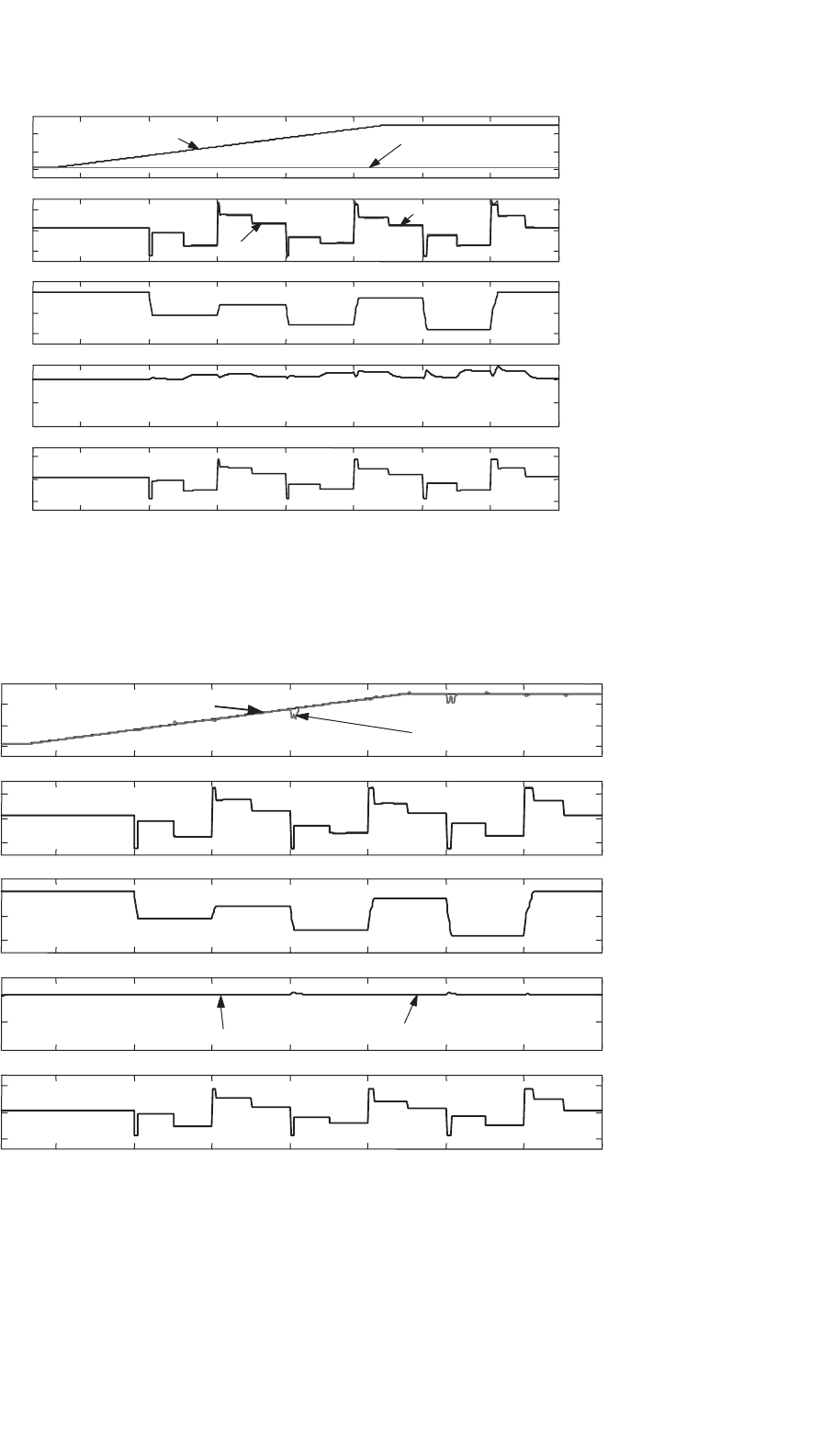
36 ANN Applications in Power Electronics and Electrical Drives 1023
6
7
8
9
R
r
R′
r
−10
0
10
−1000
0
1000
0.5
0
1
1234567
8
−5
i
qs
(Amps)
l
r
(Wb)
w
m
(rpm)
T
e
(Nm)
R
r
(W)
0
5
Time (second)
Motor
Estimated
FIGURE 36.17 Effect of rotor resistance variation without rotor resistance estimator for 40% ramp change in R
r
– modeling results.
6
7
8
9
−10
10
0
−1000
0
1000
0
0.5
1
12345678
−5
0
5
Time (second)
Motor
Estimated
R
r
R
r
i
qs
(Amps)
l
r
(Wb)
w
m
(rpm)
T
e
(Nm)
R
r
(W)
ˆ
FIGURE 36.18 Effect of rotor resistance variation with rotor resistance estimator using ANN for 40% ramp change in R
r
– modeling results.
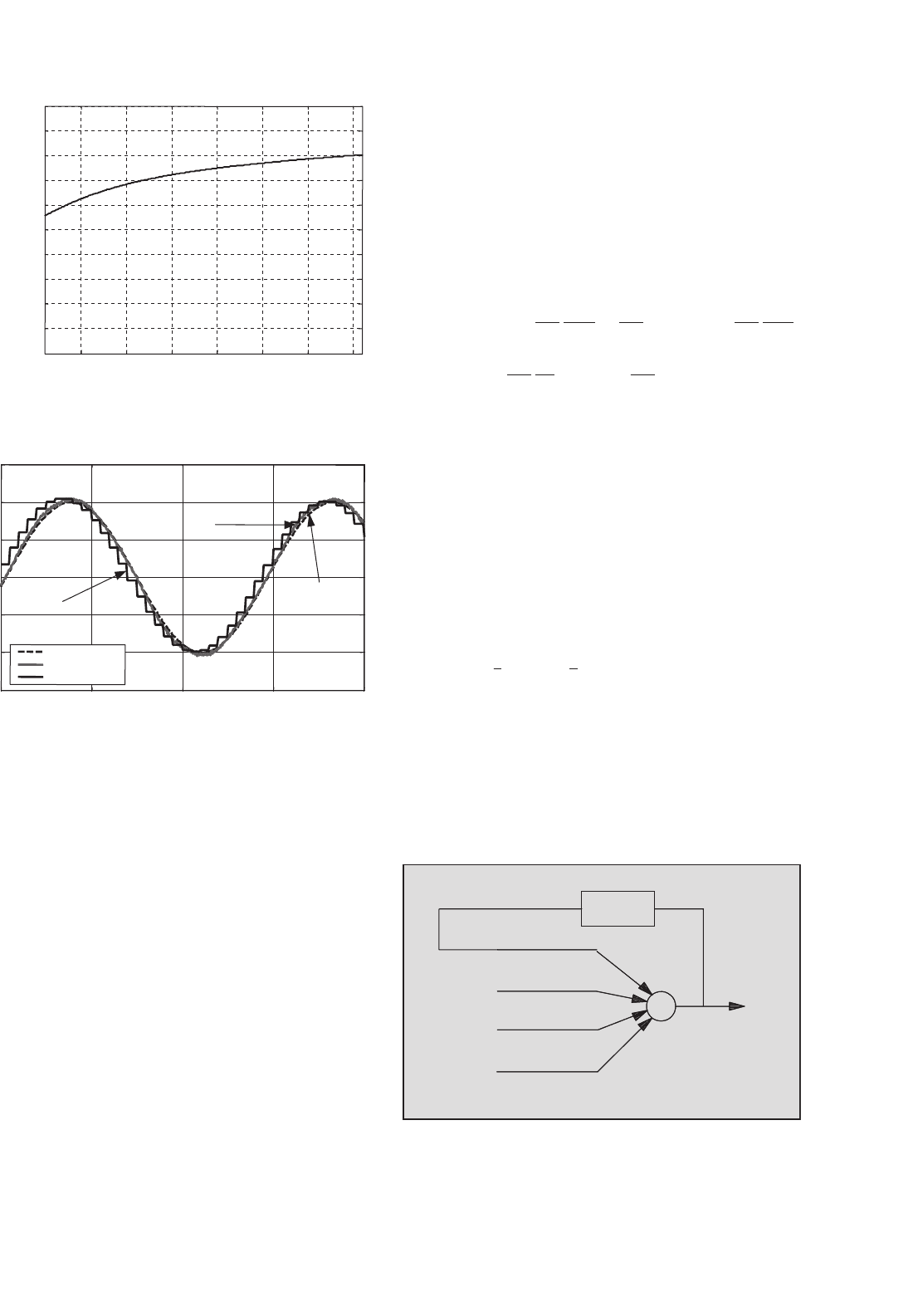
1024 B. Karanayil and M. F. Rahman
500 1000 1500 2000
Time (second)
R
r
(W)
2500 3000 3500
0
0.5
1
1.5
2
2.5
3
3.5
4
4.5
5
ˆ
FIGURE 36.19 Estimated R
r
using ANN – experimental results.
0 0.01 0.02 0.03 0.04
−1.5
−1
−0.5
0
0.5
1
1.5
current model
voltage model
neural model
d - axis rotor flux linkage, Wb
Time (second)
l
s
dr
vm
l
s
dr
im
l
s
dr
nm
FIGURE 36.20 Rotor fluxes estimated during R
r
estimation using
ANN – experimental results.
functioning very well in the experimental drive set-up. The
results of the R
r
estimation obtained from the experiment is
shown in Fig. 36.19 taken from a heat-run test conducted on
an induction motor. As the RRE calculated, the rotor resistance
using variables in stationary reference frame, the d-axis rotor
flux linkages of the current model
λ
im
dr
, the voltage model
λ
vm
dr
, and the neural model
λ
nm
dr
, taken at the end of heat
run are also recorded as shown in Fig. 36.20.
36.3.4 Stator Resistance Estimation Using ANN
In this section, the capability of a neural network has been
deployed to have on-line estimator for stator resistance
in an RFOC induction motor drive. The stator resistance
observer was realized with a recurrent neural network with
feedback loops trained using the standard back-propagation
learning algorithm. Such architecture with recurrent neural
network is known to be a more desirable approach and the
implementation reported in this section confirms this.
The d-axis stator current in the stationary reference frame
in the discrete form can be represented using the voltage and
current model equations of the induction motor,
i
s
∗
ds
(k) = W
4
i
s
∗
ds
(k − 1) + W
5
λ
s
im
dr
(k − 1) + W
6
ω
r
λ
s
im
qr
(k − 1)
+W
7
v
s
ds
(k − 1) (36.9)
where, W
4
= 1 −
T
s
σL
s
L
2
m
L
r
T
r
−
T
s
σL
s
R
s
; W
5
=
T
s
σL
s
L
m
L
r
T
r
W
6
=
T
s
σL
s
L
m
L
r
; W
7
=
T
s
σL
s
The weights W
5
, W
6
, and W
7
, are calculated using the
induction motor parameters, rotor speed ω
r
, and the sampling
interval used in the estimator T
s
.
The relationship between stator current and stator resistance
is non-linear which could be easily mapped using a neural
network.
When this Eq. (36.9) is represented graphically, it resembles
a recurrent neural network as shown in Fig. 36.21. The stan-
dard back-propagation learning rule can then be employed for
training this neural network. The weight W
4
is the result of
training so as to minimize the cumulative error function E
2
,
E
2
=
1
2
ε
2
2
(k) =
1
2
i
s
ds
(k) − i
s
∗
ds
(k)
2
(36.10)
To accelerate the convergence of the error back-propagation
learning algorithm, the current weight adjustment is supple-
mented with a fraction of the most recent weight adjustment,
as indicated in Eq. (36.11).
W
4
(k) = W
4
(k − 1) + η
2
W
4
(k) + α
2
W
4
(k − 1) (36.11)
+
W
7
W
6
W
5
W
4
z
−1
i
s*
(k)
ds
i
s*
(k −1)
ds
l
s
(k −1)
dr
im
l
s
(k −1)
qr
im
v
s
(k −1)
qr
FIGURE 36.21 d-Axis stator current estimation using recurrent neural
network based on Eq. (36.9).
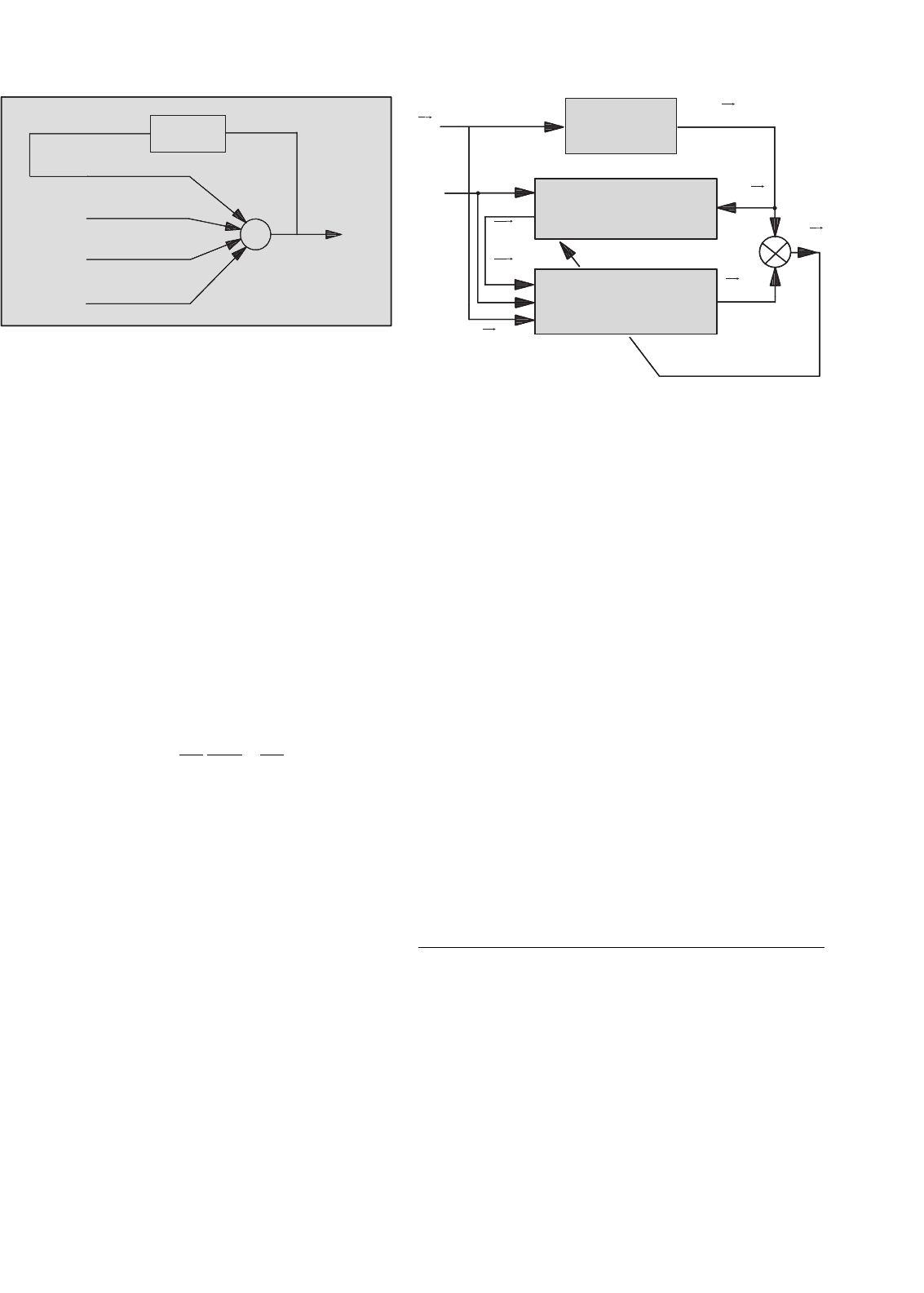
36 ANN Applications in Power Electronics and Electrical Drives 1025
+
W
7
W
6
W
5
W
4
z
−1
i
s*
(k)
ds
i
s*
(k −1)
qs
l
s
(k −1)
qr
im
l
s
(k −1)
dr
im
v
s
(k −1)
qs
FIGURE 36.22 q-Axis stator current estimation using recurrent neural
network based on Eq. (36.12).
where η
2
is the training coefficient, α
2
is a user-selected
positive momentum constant.
Following a similar procedure, the q-axis stator current of
the induction motor can be estimated using the discrete form
as shown in Eq. (36.12),
i
s
∗
qs
(k) = W
4
i
s
∗
qs
(k − 1) + W
5
λ
s
im
qr
(k − 1) − ω
r
W
6
λ
s
im
dr
(k − 1)
+W
7
v
s
qs
(k − 1) (36.12)
Equation (36.12) can be represented by a neural network
as shown in Fig. 36.22. The weight W
4
is updated with the
training based on Eq. (36.12).
The stator resistance
ˆ
R
s
of the induction motor can now be
calculated using Eq. (36.13) as follows:
ˆ
R
s
=
1 −W
4
−
T
s
σL
s
L
2
m
ˆ
R
r
L
2
r
σL
s
T
s
(36.13)
The stator resistance of an induction motor can be thus
estimated from the stator current using the neural network
system as indicated in Fig. 36.23.
36.3.4.1 Modeling Results of Stator Resistance
Estimation Using ANN
The block diagram of a rotor flux oriented induction motor
drive together with stator resistance identification is already
shown in Fig. 36.14, where the stator resistance estimation is
implemented by the stator resistance estimator (SRE) block.
The stator resistance estimation results are as shown in
Fig. 36.24. It has three results (1) without both rotor and stator
resistance estimators, (2) with only rotor resistance estima-
tion, and (3) with both rotor and stator resistance estimations.
As shown in the figure, both R
r
and R
s
were increased abruptly
by 40% at 1.5 s. It can be seen that the estimated stator resis-
tance
ˆ
R
s
converges to
ˆ
R
s
within 200 ms. It can be noted from
+
−
Induction Motor
Induction Motor
Current Model
Induction Motor
(Neural Network Model)
Weight = R
r
ˆ
v
s
s
v
s
s
l
r
s
i
s
s
i
s
s
e
2
i
s
s *
w
r
w
r
im
l
r
s
im
FIGURE 36.23 Block diagram of R
s
estimation using artificial neural
network.
this figure that the convergence of the stator resistance estima-
tion is not affected by the convergence of the rotor resistance
estimator.
36.3.4.2 Experimental Results of Stator Resistance
Estimation Using ANN
The stator resistance estimation algorithm was tested together
with the rotor flux oriented induction motor drive of Fig. 36.14
implemented in the laboratory. To test the stator resistance
estimation, an additional 3.4 per phase was added in series
with the induction motor stator, with the motor running at
1000 rev/min and with a load torque of 7.4 Nm.
The estimated stator resistance together with the actual
stator resistance is shown in Fig. 36.25. The estimated stator
resistance converges to 9.4 within less than 200 ms.
Figure 36.26 shows both the measured d-axis stator current
and the one estimated by the neural network model. The neu-
ral network model output i
s
∗
ds
(k) follows the measured values
i
s
ds
(k), due to the on-line training of the neural network.
36.4 ANN-based Controls in Motor
Drives
36.4.1 Induction Motor Current Control
Another application of ANN is to identify and control the sta-
tor current of an induction motor. In one study, Burton et al.
have used a current control strategy outlined by Wishart and
Harley to train an ANN to control the induction motor
stator currents. They have used a training algorithm named
random weight change (RWC) which is reported to be
slightly faster than back-propagation. In RWC algorithm, the
weights are perturbed by a fixed step-size and a random sign.
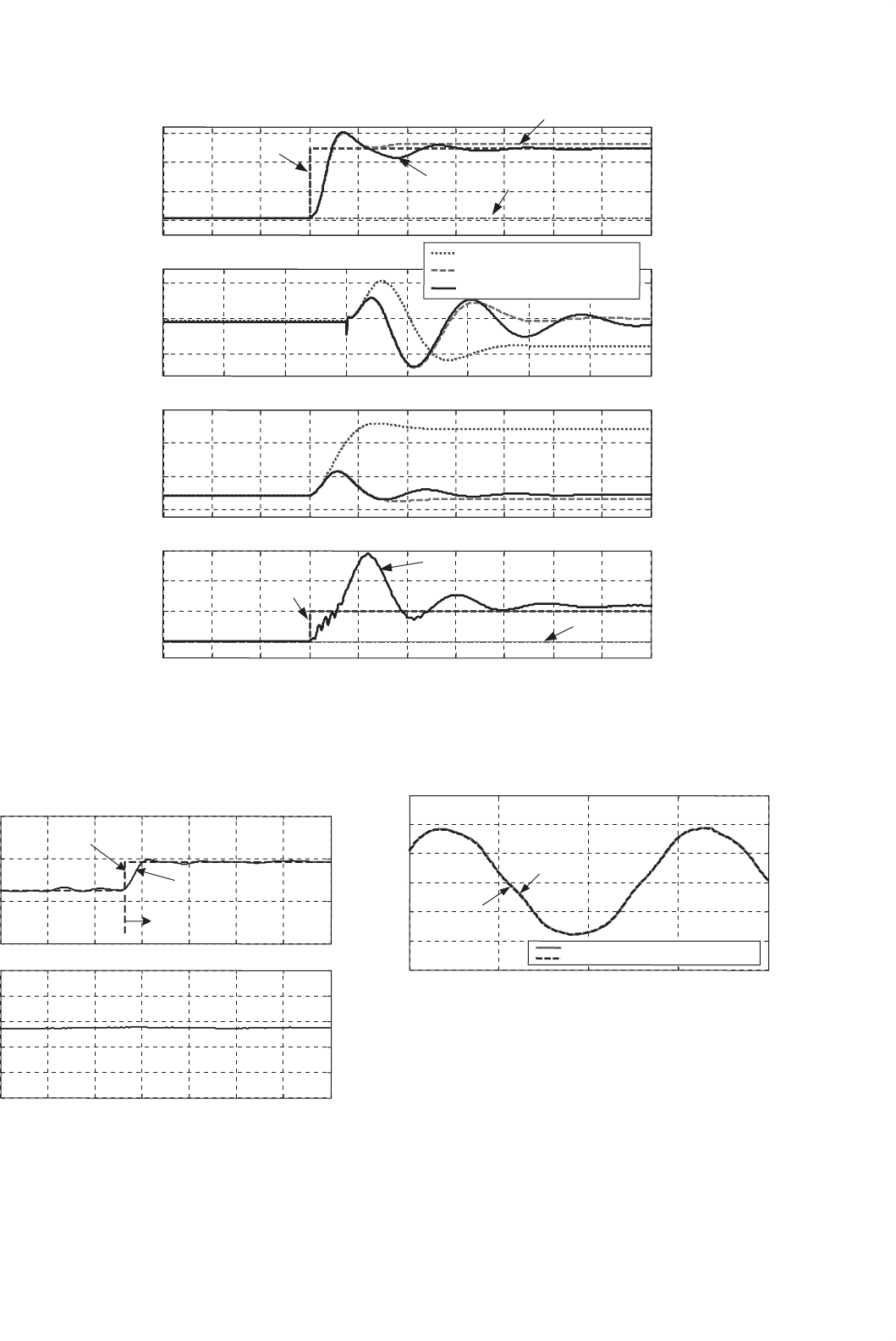
1026 B. Karanayil and M. F. Rahman
6
7
8
9
7
7.5
8
0.9
1
1.1
1.2 1.3 1.4 1.5 1.6 1.7 1.8 1.9 2 2.1 2.2
6
8
10
12
R
r
Time (second)
Without RRE and SRE
With RRE and without SRE
With RRE and SRE
(W)
(i)
(ii)
(iii)
(W)
l
rd
(Wb)
(iv)
T
e
(Nm)
R
r
ˆ
R′
r
R
r
ˆ
R
s
R
s
ˆ
R′
s
FIGURE 36.24 Performance of the drive with and without RRE and SRE using ANN for 40% step change in R
r
and R
s
, R
r
and R
s
compensated –
modeling results.
0.5 1 1.5 2 2.5 3 3.5 4
0
1
2
3
4
5
0
5
10
15
Time
(
second
)
R
r
(W)
(W)
ˆ
R
s
R
s
ˆ
3.4W
added in series
FIGURE 36.25 Estimated stator resistance R
s
using ANN – experimen-
tal results.
0 0.01 0.02 0.03 0.04
−6
−4
−2
0
2
4
6
Time (second)
Stator current (Amp)
i
s
(k)
ds
i
s*
(k)
ds
Estimated by neural network
Measured
FIGURE 36.26 Stator currents in R
s
estimation – experimental results.
This is done for fixed number of trials and after each trial,
the error with the desired output is computed. Finally, the set
of weight changes which result in the least error are chosen
and the whole process is repeated till convergence is reached.
The modeling results reported in this scheme was excellent.
Later, Burton et al. presented their practical implementation
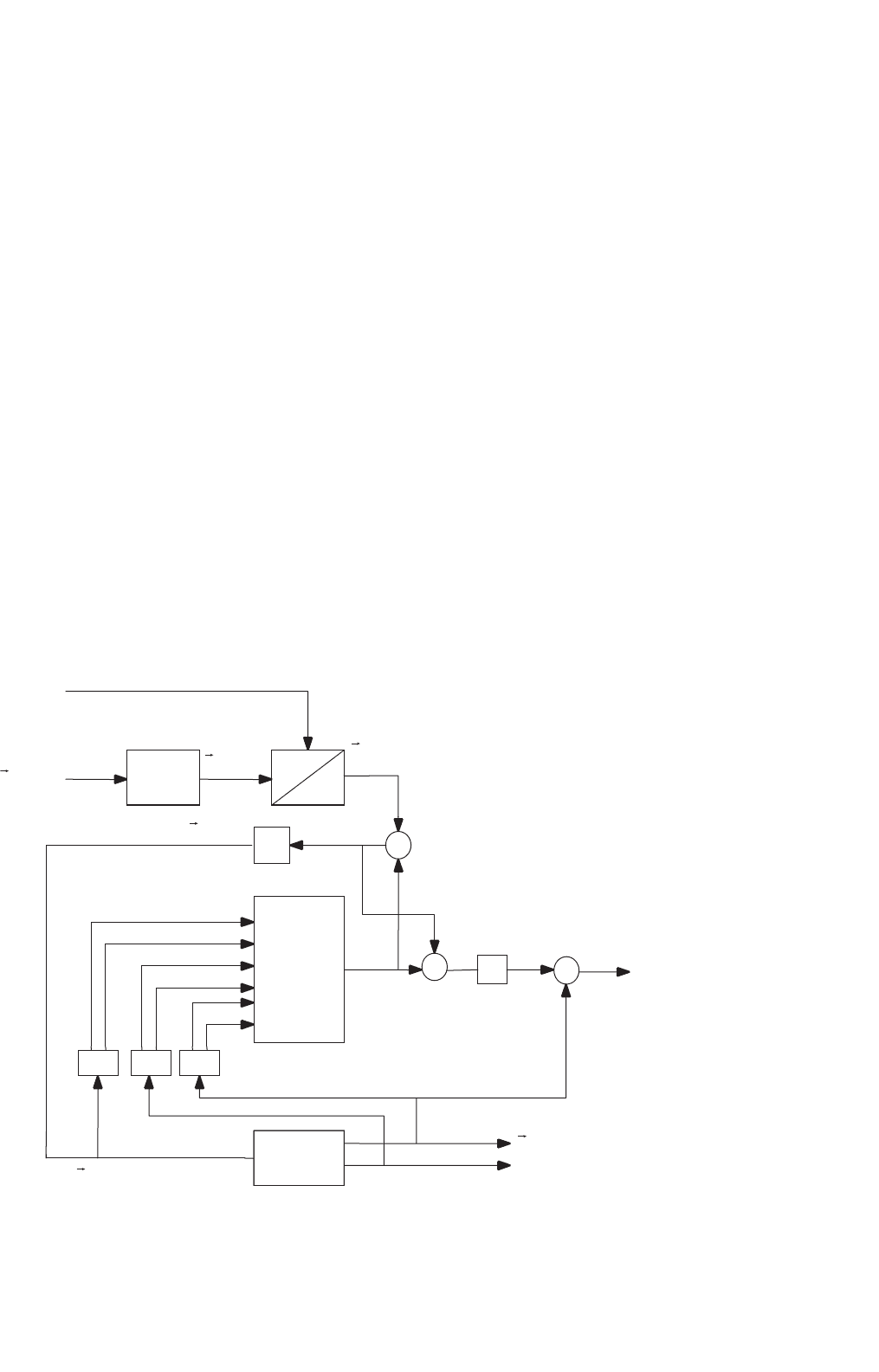
36 ANN Applications in Power Electronics and Electrical Drives 1027
of this proposed stator current controller with a transputer
controller card.
36.4.2 Induction Motor Control
Narendra and Parthasarathy proposed methods for identifica-
tion and control of dynamical systems using ANNs. Wishart
and Harley used the above basic principles to identify and
control induction machines. A block diagram of the con-
trol scheme is shown in Fig. 36.27. For the induction motor,
the Non-linear AutoRegressive Moving Average with eXoge-
nous inputs (NARMAX) model for the stationary frame stator
current is derived and used for the identification of electro-
magnetic model. In its general form, the NARMAX model
represents a system in terms of its delayed inputs and out-
puts. Random steps in the stator voltage are given for the
purpose of identification. The neural network used is of the
multilayer back-propagation type, and a quantity based on
the rotor time constant is also computed as an extra weight.
As opposed to the regular ANN architecture, this ANN has
non-linearity in the output layer and the weighted sum of the
inputs is used as the output. This gives an estimate of the rotor
time constant and makes the system robust against variation
TDLTDLTDL
−
+
+
+
+
−
v
ab
(k)
v
ab
(k)
i
s
ab
(k)
i
s
ab
(k)
Induction
Motor
ANN
Identifier
REF.
MODEL
w
r
(k)
w
e
(k+1)
e (k)
ˆ
1/Z
i
s
ab
(k+1)
ˆ
i
s
ab
(k+1)
i
s
dq
(k+1)
i
s
dq *
(k+1)
f(v, i,
speed)
a − b
d − q
1/C
v
FIGURE 36.27 Adaptive current control using ANN proposed by Harley.
of the parameters. Once, the identification is over, the ANN is
used for current control. The stator currents predicted by the
ANN are used to compute the input voltage for the induction
motor, and the ANN output is made to track the reference
currents by back-propagating the error.
The rotor speed is also controlled in this system by identi-
fying a NARMAX model for the speed increment rather than
the absolute value of speed. To simplify the NARMAX model,
the load torque is assumed to be a function of the motor
speed, as is the case in a fan or pump type of load. For the
current control case, the relationship between the control vari-
able (voltage) and the controlled quantity (current) was linear.
In the speed control case, this relationship is non-linear, thus
necessitating two ANNs, one for identification of speed and
the other for control.
The identification ANN (N
i
) predicts the value for the speed
increment, which is compared with the actual speed incre-
ment and the error
(
ε
i
)
is back-propagated through the ANN.
A PI controller is used for basic speed control, and the con-
trol ANN (N
c
) produces the slip frequency, and the difference
between the desired speed increment and actual speed incre-
ment (ε
c
) is back-propagated through the ANN. The induction
motor drive therefore employs three ANNs as shown in
Fig. 36.28.
